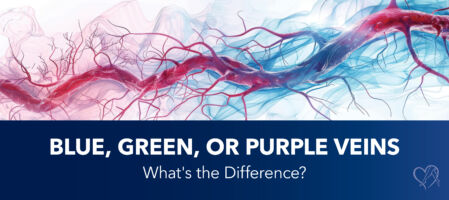
We all catch glimpses of our veins—when we flex at the gym, rest an arm on the desk, or kick back on the couch. Typically, those thin lines are no big deal. Yet their color, size, and feel can tell a deeper story about what’s happening under the skin.
Understanding the difference between vein colors can help you spot early hints of vein disease and protect your long‑term vein health. In this post, we’ll explain why some veins look blue and others green or purple. We’ll then discuss some basic signs indicating poor blood circulation and share insights about the modern options your vein doctor can provide if trouble starts brewing.
Are you concerned about the appearance of your veins? Let the vein experts at Center for Vein Restoration (CVR) provide the clarity and compassion your legs deserve as we help you navigate your treatment options and manage your care and recovery journey. Call 240-965-3915 or visit our SCHEDULING PORTAL to book a consultation at a CVR vein clinic near you.

Blood inside every vein is a shade of dark red, but most of us see blue. According to the Cleveland Clinic, this shade is a result of physics. Red wavelengths dive deeper when light hits our skin, while blue wavelengths bounce back sooner. Because superficial veins—that is, veins close to the surface of the skin—sit just a few millimeters underneath, the returning blue light is what our eyes capture.
Normally, blue veins flatten when an arm or leg is raised above heart level because gravity helps blood drain back to the chest. If they stay swollen, ache, itch, or throb—especially at the end of a long workday—there might be a bigger issue, such as chronic venous insufficiency. Why does this happen?
Inside each vein are tiny one‑way valves, and when they weaken, blood slips backward and collects, a condition known as chronic venous insufficiency. Over time, the pressure stretches the vein wall. A blue thread may bulge outward and become a twisted varicose vein that feels heavy and sore.
According to Healthline, most visible veins aren’t anything to worry about, but if blue veins are causing irritating symptoms, schedule an ultrasound with a board-certified CVR vein doctor. Catching problems early is the best way to avoid skin damage, ulcers, and other long-term discomfort as the issue progresses.

Blue veins are common, but plenty of people also spot green blood vessels, especially those with lighter-colored skin. Superficial green veins may be most visible on the chest, forehead, neck, thighs, abdomen, and shins, to name a few.
According to Healthline, visible green veins are only a sign of trouble if accompanied by symptoms such as leg pain and swelling. More on this later.
Meanwhile, purple veins usually appear on the legs, ankles, and behind the knees. They, too, are mostly a cosmetic concern. Still, their sudden visibility can signal early vein disease, so think of them as your body’s polite nudge to pay attention before heaviness, swelling, or cramps manifest or worsen. This is the perfect time to consider scheduling a brief consultation with a trusted vein expert and commit to proactive, confidence‑boosting vein care.
Your journey begins by taking our quick self‑assessment, which offers helpful insights into whether professional vein treatment is the right fit for you.
The takeaway about vein color: It’s not the shade that signals trouble, but when blue, green, or purple veins come with certain symptoms, including swelling and itching, don’t shrug it off, even if they’re only mildly irritating. These signs may indicate early-stage vein disease that a vascular specialist should evaluate. Let’s dig deeper into the specific symptoms of vein disease.
Remember, color alone can be misleading, so it’s essential to watch for a set of symptoms that mean blood isn’t normally flowing upward and back toward the heart:
Simply put, an early diagnosis of chronic venous insufficiency typically means simpler treatment and faster relief, making it critical to monitor physical symptoms rather than look at vein color alone.
If you have been diagnosed with vein disease, rest assured: several lifestyle changes can provide temporary relief from uncomfortable symptoms and prevent the progression of the condition. One of the most common short-term remedies is medical-grade compression stockings. These snug socks gently squeeze the legs to improve blood flow, reduce swelling, and help prevent or manage vein conditions. Ask your CVR vein care physician for more information about the best way to incorporate compression therapy into your treatment routine.
Remember, vein disease is progressive, and CVR is here to help you navigate professional treatment options.
Most minimally invasive treatments are meant to close faulty veins from the inside or remove them through tiny punctures. Here are some of the most common:
All four options typically take under an hour, require only small bandages, and allow patients to walk out of the office the same day. Once the damaged vessel is closed, blood reroutes instantly to nearby healthy veins, boosting circulation. This improves symptoms in the long term since overall vein health is better.
Seeing different shades of vein color underneath your skin is part of being human, but physical symptoms, including leg cramps, swelling, and itching, shouldn’t be ignored, since they may be direct indicators of vein health. Visiting with a board-certified CVR vein physician can clarify circulatory issues that need urgent care. Staying proactive saves you from chronic discomfort and keeps you moving with confidence for years to come.
Don’t wait for uncomfortable symptoms to worsen. If you're struggling to manage signs of vein disease, book an appointment with a CVR board-certified vein specialist to explore treatment options that will improve your quality of life. Call 240-965-3915 to speak to a Patient Services Representative or schedule your consultation online at a CVR near you today.

